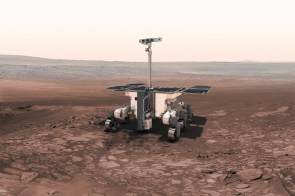ExoMars Mission (2022)
 |
| The ExoMars rover. Credit: ESA |
During launch and cruise phase, a carrier module (provided by ESA) will transport the surface platform and the rover within a single aeroshell. A descent module (provided by Roscosmos with some contributions by ESA) will separate from the carrier shortly before reaching the Martian atmosphere. During the descent phase, a heat shield will protect the payload from the severe heat flux. Parachutes, thrusters, and damping systems will reduce the speed, allowing a controlled landing on the surface of Mars.
After landing, the rover will egress from the platform to start its science mission. The primary objective is to land the rover at a site with high potential for finding well-preserved organic material, particularly from the very early history of the planet. The rover will establish the physical and chemical properties of Martian samples, mainly from the subsurface. Underground samples are more likely to include biomarkers, since the tenuous Martian atmosphere offers little protection from radiation and photochemistry at the surface.
The drill is designed to extract samples from various depths, down to a maximum of two metres. It includes an infrared spectrometer to characterise the mineralogy in the borehole. Once collected, a sample is delivered to the rover’s analytical laboratory, which will perform mineralogical and chemistry determination investigations. Of special interest is the identification of organic substances. The rover is expected to travel several kilometres during its mission.
The ExoMars Trace Gas Orbiter, part of the 2016 ExoMars mission, will support communications. The Rover Operations Control Centre (ROCC) will be located in Turin, Italy. The ROCC will monitor and control the ExoMars rover operations. Commands to the Rover will be transmitted through the Orbiter and the ESA space communications network operated at ESA's European Space Operations Centre (ESOC).

